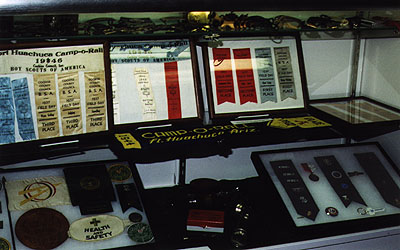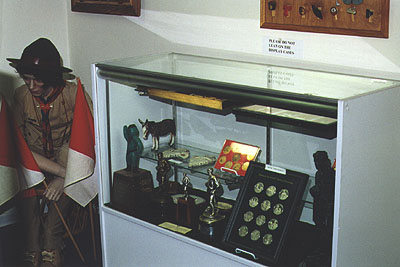







|
|
DISPLAY ROOM

The Display Room contains our most diversified collection of memorabilia.
We have a rare and quite complete collection of books by Ernest Thompson
Seton, dating back to 1899. Excerpts taken from these books were incorporated
into the first Boy Scout Handbook. Books by Dan Beard date back to 1882.
The Development of the Scout Handbook and Merit Badge Program is quite
interesting. Scouting for Boys by Lord Baden-Powell of Gilwell, 1908,
had no standard advancement tests. Then came Boy Scouts of America by
Ernest Thompson Seton and Lieut-General Sir Robert S. S. Baden-Powell,
K.C.B., 1910. Ernest Thompson Seton was authorized to put together a
temporary Scout Handbook. This he did by taking part of the 1908 Scouting
for Boys by Baden-Powell and part from his Manual of Woodcraft Indians,
adding the outline for the American Boy Scout program. This included
Tenderfoot, Second Class, First Class and the 14 English merit badges.
oy Scouts by John L. Alexander, illustrated by Gordon Grant, August
1911, called The Tapioca Book, (on display). It contained Tenderfoot,
Second Class, and First Class requirements and six merit badges. Then
came the Boy Scouts of America, Handbook for Boys, 1911. This was the
first complete official edition of the American program, in August 1911.
It was followed by Boy Scouts of America, Handbook for Boys, and Handbook
for Boys, BSA, 1929.
On display are Badge books dating back to 1925. There is Bird Study
1925, which can be compared to the 1969 to present version. Pioneering
1928, had only a design change. Pathfinding 1930, was discontinued in
1952. Handicraft 1930, was changed to Home Repairs in 1943. Rocks and
Minerals 1937, was Mining previously from 1911-1937.
There are Boy Scout Handbooks from 1910 through 1998. Boys Life Magazines
date back to the 1920's and 1930's. There are donated scouting items
from personal collections; sterling silver Norman Rockwell coins; Otis
Chidester's personal collection of scouting die casts; his pins and
personal memoribilia; donated pins of all categories; English and American
Sea Scout display; a bugle used the first summer Camp Lawton was opened
in 1921; uniforms belonging to Otis and others dating back to the teens
and forward are all on display. The walls have rotating displays of
Pimarees (American and Mexican Scouting), Order of the Arrow, World
Scouting, etc.

The wall displays will be rotated, depicting various scouting themes
such as Order of the Arrow, Camporees/Jamborees, etc.
|